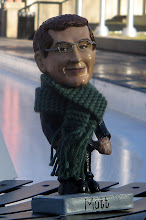The closest analogy may be what has happened to our sense of pitch. In 1740, when Handel rang his tuning fork, an A above middle C had a frequency of four hundred and twenty-two hertz. Throughout the nineteenth century, orchestras were tuning it higher, straining to fill larger and larger halls and make their sound just a little more brilliant. These days, when Lorin Maazel rings his tuning fork, that same A gives a steady pitch of four hundred and forty hertz, but some conductors in Germany and Austria have gone up another five hertz. In music, if you go too high, strings snap and voices crack. In the matter of sweets, the only real limit is exhaustion: when [molecular biologist Charles] Zuker offers sugar water to his mice, they keep on drinking until their tongues can hardly move.The analogy might not work quite perfectly - we all get sugar cravings, but rarely wish our favorite songs were a quarter-tone sharper. Still that steady rise in our collective pitch center is worth considering. The sounding of the A is a permanent fixture of classical music concerts, the moment we all cease our own frenzied warm-up rituals and agree to play together - at least for one note - perfectly in tune. Tuning in fact is a ritual itself, with a prescribed order and etiquette, as much about connecting with tradition as getting all our C-strings to match. If Bilger's analogy holds, though, our traditional pitch ritual may be inevitably creeping up towards dog-whistle territory.
- p. 46
Even for bass players, brighter often is better - why else would our solo strings tune up a whole step higher? I've never snapped any strings personally - they're pretty elastic, especially on the bass - but I know that pitch fluctuations are a constant source of frustration for singers and wind players. They have to make all kinds of awkward adjustments to play at a higher pitch. And just because a concert begins at A=440, doesn't mean it ends there. Orchestras consistently drift quite a bit sharper, sort of like a symphonic sugar spike.
Perhaps in response to irrational pitch exuberance, some orchestras have tried to set limits on the inflation of the A. The first line of our contract at the Spoleto Festival USA reads:
THE PITCH OF THE SPOLETO FESTIVAL USA IS A=440That's right, bold case capitals and underlined. It's also a larger font than the rest of the contract. I haven't heard of anyone getting fired for playing A=441 yet. But I wouldn't chance it.
In fact both pitch and sweetness are highly refined, complex and sophisticated tastes. Good musicians and cooks use them in subtle ways to heighten a color or flavor, establish a tonality, bring an expression into relief, etc. I'm always trying to hone my sense of pitch, to become more conscious of how I'm tempering the scale and what impact this is having.
If you read the rest of Burkhard's article, you might be quite horrified to learn how chemicals are being manipulated and quietly snuck into our food supply to satisfy (and increase) our sweetness cravings. Fortunately I don't have access to a laboratory full of genetically altered mice on which to hold intonation experiments, though I have subjected myself and unfortunate listeners to plenty of too-sharp (and flat) performances. No lasting damage so far - hopefully no creatures will have to die for me to find a secure sense of pitch.


 Technorati Link Count: no. of blog reactions to this post
Technorati Link Count: no. of blog reactions to this post
2 comments:
440 is a nice round number, so let's hope it stays there. Plus we have nice scientific measuring equipment to keep things a bit more standardized these days, so hopefully that will help prevent hertzcreep.
Hasn't pitch, though, gone up AND down ... and then back up again? I read that somewhere; I can't find it now, though (sorry!). So the analogy sort of breaks down IF what I write is true.
San Francisco's audition notices tell us they tune at a 441. Sigh.
Post a Comment